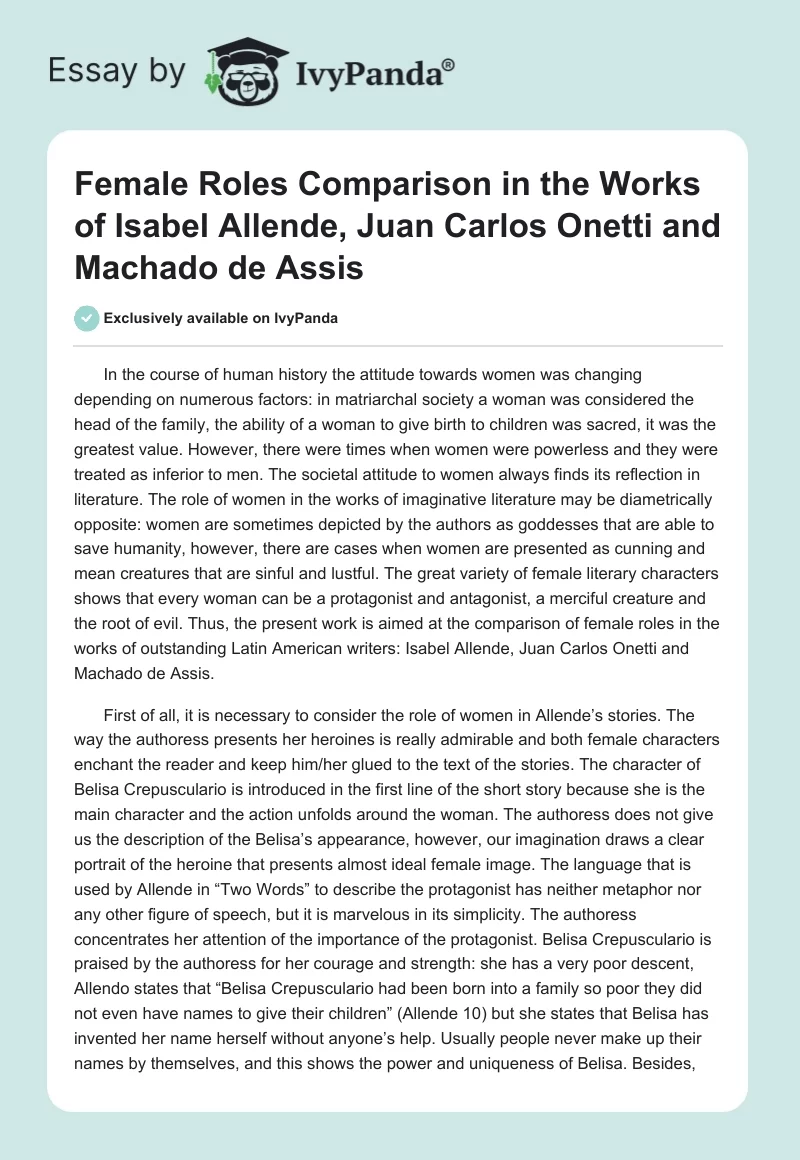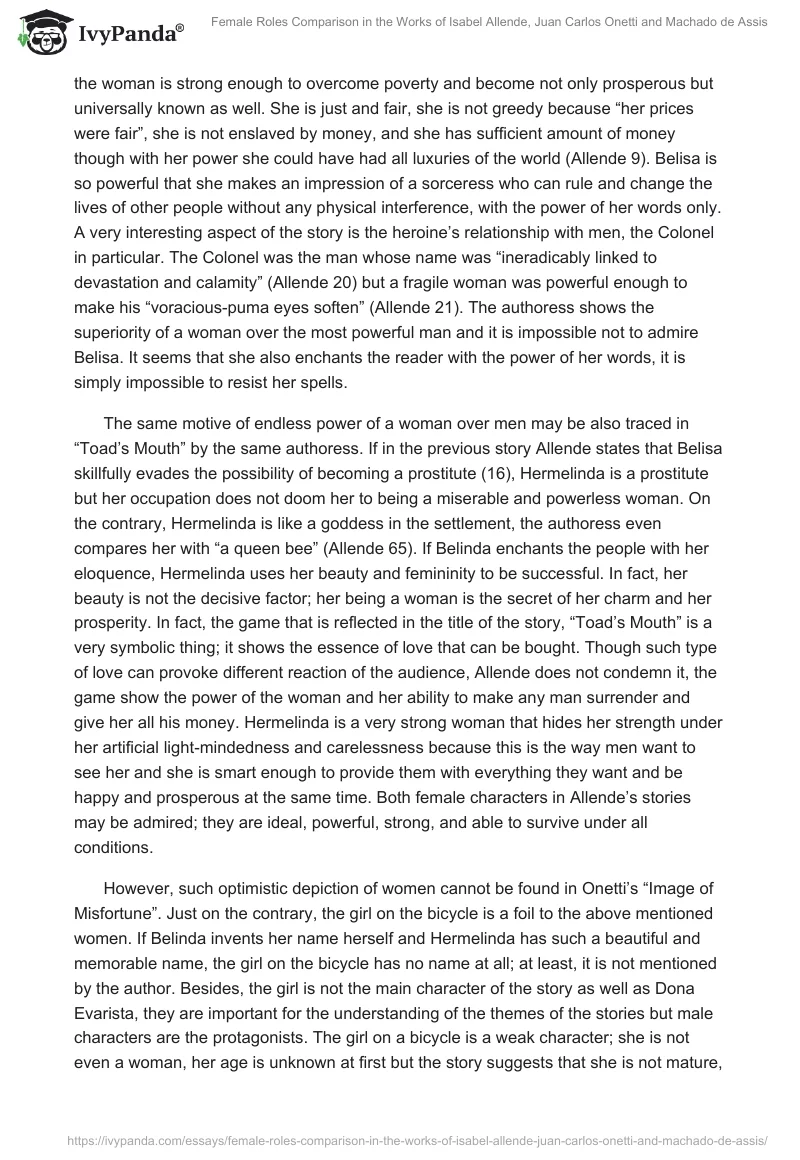In the course of human history the attitude towards women was changing depending on numerous factors: in matriarchal society a woman was considered the head of the family, the ability of a woman to give birth to children was sacred, it was the greatest value. However, there were times when women were powerless and they were treated as inferior to men. The societal attitude to women always finds its reflection in literature. The role of women in the works of imaginative literature may be diametrically opposite: women are sometimes depicted by the authors as goddesses that are able to save humanity, however, there are cases when women are presented as cunning and mean creatures that are sinful and lustful. The great variety of female literary characters shows that every woman can be a protagonist and antagonist, a merciful creature and the root of evil. Thus, the present work is aimed at the comparison of female roles in the works of outstanding Latin American writers: Isabel Allende, Juan Carlos Onetti and Machado de Assis.
First of all, it is necessary to consider the role of women in Allende’s stories. The way the authoress presents her heroines is really admirable and both female characters enchant the reader and keep him/her glued to the text of the stories. The character of Belisa Crepusculario is introduced in the first line of the short story because she is the main character and the action unfolds around the woman. The authoress does not give us the description of the Belisa’s appearance, however, our imagination draws a clear portrait of the heroine that presents almost ideal female image. The language that is used by Allende in “Two Words” to describe the protagonist has neither metaphor nor any other figure of speech, but it is marvelous in its simplicity. The authoress concentrates her attention of the importance of the protagonist. Belisa Crepusculario is praised by the authoress for her courage and strength: she has a very poor descent, Allendo states that “Belisa Crepusculario had been born into a family so poor they did not even have names to give their children” (Allende 10) but she states that Belisa has invented her name herself without anyone’s help. Usually people never make up their names by themselves, and this shows the power and uniqueness of Belisa. Besides, the woman is strong enough to overcome poverty and become not only prosperous but universally known as well. She is just and fair, she is not greedy because “her prices were fair”, she is not enslaved by money, and she has sufficient amount of money though with her power she could have had all luxuries of the world (Allende 9). Belisa is so powerful that she makes an impression of a sorceress who can rule and change the lives of other people without any physical interference, with the power of her words only. A very interesting aspect of the story is the heroine’s relationship with men, the Colonel in particular. The Colonel was the man whose name was “ineradicably linked to devastation and calamity” (Allende 20) but a fragile woman was powerful enough to make his “voracious-puma eyes soften” (Allende 21). The authoress shows the superiority of a woman over the most powerful man and it is impossible not to admire Belisa. It seems that she also enchants the reader with the power of her words, it is simply impossible to resist her spells.
The same motive of endless power of a woman over men may be also traced in “Toad’s Mouth” by the same authoress. If in the previous story Allende states that Belisa skillfully evades the possibility of becoming a prostitute (16), Hermelinda is a prostitute but her occupation does not doom her to being a miserable and powerless woman. On the contrary, Hermelinda is like a goddess in the settlement, the authoress even compares her with “a queen bee” (Allende 65). If Belinda enchants the people with her eloquence, Hermelinda uses her beauty and femininity to be successful. In fact, her beauty is not the decisive factor; her being a woman is the secret of her charm and her prosperity. In fact, the game that is reflected in the title of the story, “Toad’s Mouth” is a very symbolic thing; it shows the essence of love that can be bought. Though such type of love can provoke different reaction of the audience, Allende does not condemn it, the game show the power of the woman and her ability to make any man surrender and give her all his money. Hermelinda is a very strong woman that hides her strength under her artificial light-mindedness and carelessness because this is the way men want to see her and she is smart enough to provide them with everything they want and be happy and prosperous at the same time. Both female characters in Allende’s stories may be admired; they are ideal, powerful, strong, and able to survive under all conditions.
However, such optimistic depiction of women cannot be found in Onetti’s “Image of Misfortune”. Just on the contrary, the girl on the bicycle is a foil to the above mentioned women. If Belinda invents her name herself and Hermelinda has such a beautiful and memorable name, the girl on the bicycle has no name at all; at least, it is not mentioned by the author. Besides, the girl is not the main character of the story as well as Dona Evarista, they are important for the understanding of the themes of the stories but male characters are the protagonists. The girl on a bicycle is a weak character; she is not even a woman, her age is unknown at first but the story suggests that she is not mature, if in Hermelinda’s description the authoress emphasizes her female features, breast and intimate parts of body, Onetti mentions that the girl was “without breasts as yet” (262). Besides, the first time the protagonist meats the girl, she is exhausted and takes a break. This would be impossible for Allende’s characters because they are strong and seem never to be tired. Onetti’s narrator says that he loves the girl and wants to protect her because her face is the face of misfortune (Onetti 269). Thus, for Onetti the secret of the girl’s charm is in her vulnerability, weakness, and her imperfection, her deafness. However, the girl is not a cripple as she makes the protagonist happy at least for a short period of time due to their sexual contact.
The character of Dona Evarista created by Assis may be also contrasted with Allende’s characters of women. The author states directly that Dona Evarista is an absolutely unattractive woman of twenty five (Assis 14). Her age is the perfect age to give birth to children, however, the woman is sterile, she is unable to produce heir and, consequently, she is not a woman at all because she is unable to fulfill her main mission. Besides, the woman is unloved by her husband, it is stated directly that the psychiatrist marries her because she fits physiological requirements that turns out to be not true. In fact, Evarista is the root of evil in the story, it is because of her that her husband becomes so absorbed in science and tortures the whole town. Evarista is praised and given compliments only because she is the wife of the alienist and because people think that it is in her power to stop his tyranny. As the character, Evarista is shallow and unproductive; she differs from the female characters from other stories.
Drawing a conclusion, it may be stated that the analyzed stories present great diversity of female characters. If Allende’s Belisa and Hermelinda are bright and picturesque characters that present strong and powerful women that are self-sufficient and beautiful, Onetti’s heroine is not ideal but mysterious and beautiful in her weakness. Finally, Assis presents another type of female character: grotesque and satirical, his Evarista is sterile in intellectual and physical sense.
Works Cited
Allende, Isabel. “Two Words.” The Stories of Eva Luna. NY: Scibner, 2001: 7-21.
Allende, Isabel. “Toad’s Mouth.” The Stories of Eva Luna. NY: Scibner, 2001: 57-69.
Machado de Assis, Joaquim Maria and William L Grossman. The psychiatrist and other stories. University of California Press, 1963.
Onetti, Juan Carlos. “The Image of Misfortune.” Echevarría, Roberto Gonzalez. The Oxford Book of Latin American Short Stories. Oxford: Oxford University Press, 1999.


